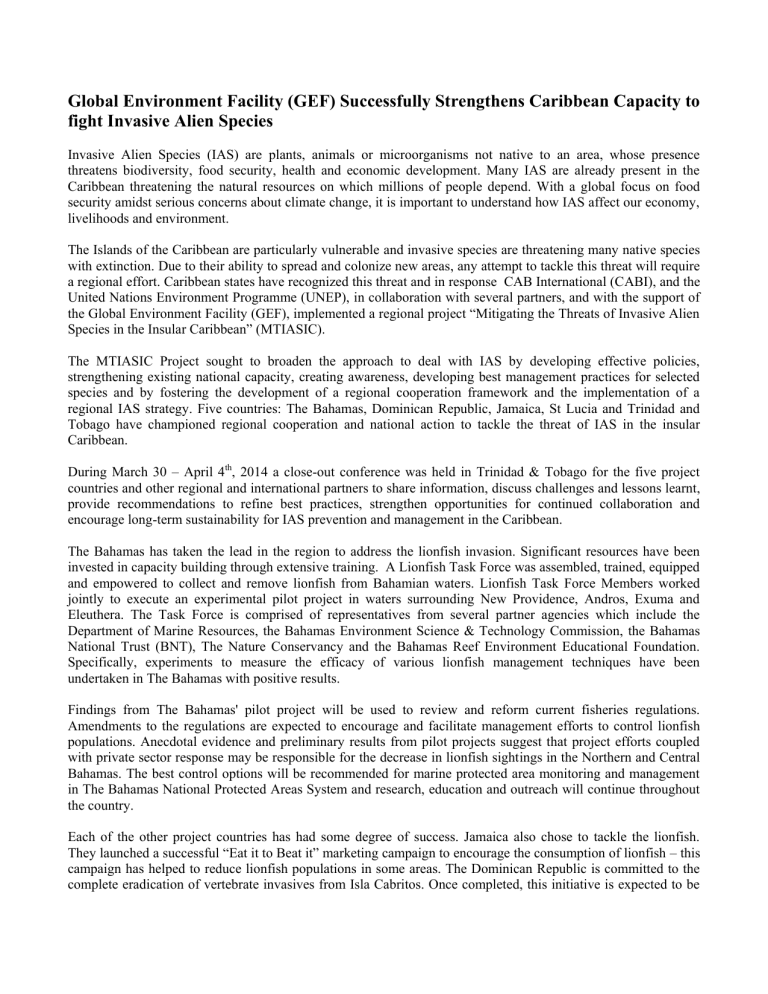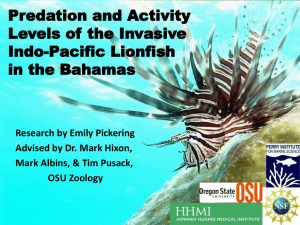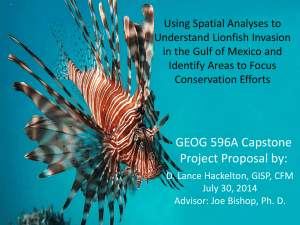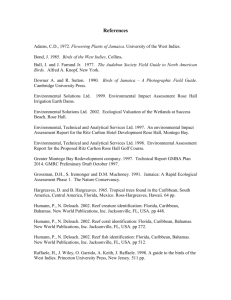Read Press Release

Global Environment Facility (GEF) Successfully Strengthens Caribbean Capacity to fight Invasive Alien Species
Invasive Alien Species (IAS) are plants, animals or microorganisms not native to an area, whose presence threatens biodiversity, food security, health and economic development. Many IAS are already present in the
Caribbean threatening the natural resources on which millions of people depend. With a global focus on food security amidst serious concerns about climate change, it is important to understand how IAS affect our economy, livelihoods and environment.
The Islands of the Caribbean are particularly vulnerable and invasive species are threatening many native species with extinction. Due to their ability to spread and colonize new areas, any attempt to tackle this threat will require a regional effort. Caribbean states have recognized this threat and in response CAB International (CABI), and the
United Nations Environment Programme (UNEP), in collaboration with several partners, and with the support of the Global Environment Facility (GEF), implemented a regional project “Mitigating the Threats of Invasive Alien
Species in the Insular Caribbean” (MTIASIC).
The MTIASIC Project sought to broaden the approach to deal with IAS by developing effective policies, strengthening existing national capacity, creating awareness, developing best management practices for selected species and by fostering the development of a regional cooperation framework and the implementation of a regional IAS strategy. Five countries: The Bahamas, Dominican Republic, Jamaica, St Lucia and Trinidad and
Tobago have championed regional cooperation and national action to tackle the threat of IAS in the insular
Caribbean.
During March 30 – April 4 th
, 2014 a close-out conference was held in Trinidad & Tobago for the five project countries and other regional and international partners to share information, discuss challenges and lessons learnt, provide recommendations to refine best practices, strengthen opportunities for continued collaboration and encourage long-term sustainability for IAS prevention and management in the Caribbean.
The Bahamas has taken the lead in the region to address the lionfish invasion. Significant resources have been invested in capacity building through extensive training. A Lionfish Task Force was assembled, trained, equipped and empowered to collect and remove lionfish from Bahamian waters. Lionfish Task Force Members worked jointly to execute an experimental pilot project in waters surrounding New Providence, Andros, Exuma and
Eleuthera. The Task Force is comprised of representatives from several partner agencies which include the
Department of Marine Resources, the Bahamas Environment Science & Technology Commission, the Bahamas
National Trust (BNT), The Nature Conservancy and the Bahamas Reef Environment Educational Foundation.
Specifically, experiments to measure the efficacy of various lionfish management techniques have been undertaken in The Bahamas with positive results.
Findings from The Bahamas' pilot project will be used to review and reform current fisheries regulations.
Amendments to the regulations are expected to encourage and facilitate management efforts to control lionfish populations. Anecdotal evidence and preliminary results from pilot projects suggest that project efforts coupled with private sector response may be responsible for the decrease in lionfish sightings in the Northern and Central
Bahamas. The best control options will be recommended for marine protected area monitoring and management in The Bahamas National Protected Areas System and research, education and outreach will continue throughout the country.
Each of the other project countries has had some degree of success. Jamaica also chose to tackle the lionfish.
They launched a successful “Eat it to Beat it” marketing campaign to encourage the consumption of lionfish – this campaign has helped to reduce lionfish populations in some areas. The Dominican Republic is committed to the complete eradication of vertebrate invasives from Isla Cabritos. Once completed, this initiative is expected to be
replicated at other sensitive sites. St. Lucia has experimented with various methodologies to control an invasive iguana species and prevent it from cross breeding with native iguanas. Trinidad and Tobago’s Government has approved the establishment of a multi-sectorial committee and an invasive species unit. The unit has been tasked with the development of invasive species management initiatives. The designation of the committee will allow for increased collaboration and exchange among key agencies.
All five participating countries have committed to specific measures to ensure that the gains made under the
MTIASIC Project are maintained and advanced. A key factor in the success of the project has been knowledge generation. The management and dissemination of vital information is expected to continue beyond the project through a regional website. The website www.ciasnet.org was designed as a “one stop shop” for information on
IAS in the Caribbean.
CABI, together with other agencies will continue to provide support to Caribbean States in an attempt to raise awareness about IAS. The project has clearly demonstrated that invasive species can be effectively managed with substantial benefits for the conservation of biodiversity and economic development. Analyses carried out under the MTIASIC Project show sizeable economic gains when managing IAS. These findings suggest that it makes pure economic sense for governments to invest in the development and implementation of solutions to the invasive alien species problem. The Bahamas is committed to addressing the lionfish invasion problem as well as other target invasive alien species.
For further information, please contact Mr. Michael Braynen, Director of the Department of Marine
Resources, at (242) 393-1777 .
Bahamas Delegation attended MTIASIC Symposium & Final Meeting in Port of Spain, Trinidad
Pictured (left to right) Mark Daniels, Leon Levy Preserve Manager, BNT, Ingeria Miller, Forestry Environmental
Officer, Janeen Bullard, Environmental Consultant, Krista Sherman, GEF FSP Coordinator, BNT, Frederick
Arnett II, Assistant Fisheries Officer within the Department of Marine Resources.







